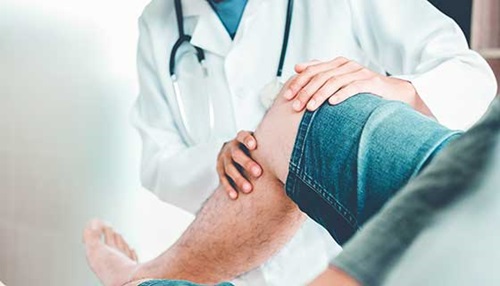Osteoarthritis
What is osteoarthritis?
Osteoarthritis is the most common form of arthritis. It is a chronic degenerative joint disease that affects mostly middle-aged and older adults. Osteoarthritis causes the breakdown of joint cartilage. It can occur in any joint, but it most often affects the hands, knees, hips, or spine.
What causes osteoarthritis?
Osteoarthritis can be classified as primary or secondary. Primary osteoarthritis has no known cause. Secondary osteoarthritis is caused by another disease, infection, injury, or deformity. Osteoarthritis starts with the breakdown of cartilage in the joint. As the cartilage wears down, the bone ends may thicken and form bony growths (spurs). Bone spurs interfere with joint movement. Bits of bone and cartilage may float in the joint space. Fluid-filled cysts may form in the bone and limit joint movement.
Who is at risk for osteoarthritis?
The risk factors of osteoarthritis include:
-
Heredity. Slight joint defects or double-jointedness (laxity) and genetic defects may contribute to osteoarthritis.
-
Excess weight. Being overweight or obese can put stress on such joints as the knees over time.
-
Injury or overuse. Severe injury to a joint, such as the knee, can lead to osteoarthritis. Injury may also result from overuse or misuse over time.
What are the symptoms of osteoarthritis?
The most common symptom of osteoarthritis is pain after overuse or inactivity of a joint. Symptoms usually develop slowly over years. Symptoms can occur a bit differently in each person, and may include:
-
Joint pain
-
Joint stiffness, especially after sleep or inactivity
-
Less movement in the joint over time
-
A grinding feeling of the joint when moved, as the cartilage wears away (in more advanced stages)
The symptoms of osteoarthritis can look like other health conditions. Make sure to see your healthcare provider for a diagnosis.
Seminar Management of Knee Arthritis

How is osteoarthritis diagnosed?
The process starts with a medical history and a physical exam. You may also have X-rays. This test uses a small amount of radiation to create images of bone and other body tissues.
How is osteoarthritis treated?
Treatment will depend on your symptoms, age, and general health. It will also depend on how severe the condition is. The goal of treatment is to reduce joint pain and stiffness, and improve joint movement. Treatment may include:
-
Exercise. Regular exercise, including stretching and strengthening, may help reduce pain and other symptoms.
-
Heat treatment. Treating the affected joint with heat may help reduce pain.
-
Physical and occupational therapy. These types of therapy may help to reduce joint pain, improve joint flexibility, and reduce joint strain. Splints and other assistive devices may also be used.
-
Weight maintenance. Keeping a healthy weight or losing weight if needed may help to prevent or reduce symptoms.
-
Medicines. These may include pain relievers and anti-inflammatory medicines. Either may be taken by mouth as a pill, or rubbed on the skin as a cream.
-
Injections of thick liquids into the joints. These liquids mimic normal joint fluid.
-
Joint surgery. Surgery may be needed to repair or replace a severely damaged joint.
Talk with your healthcare providers about the risks, benefits, and possible side effects of all medicines.
What are the complications of osteoarthritis?
Because osteoarthritis causes joints to degenerate over time, it can cause disability. It can cause pain and movement problems that make a person less able to do normal daily activities and tasks.
Hand Arthritis | Bill's Story
Living with Osteoarthritis
Although there is no cure for osteoarthritis, it is important to help keep joints functioning by reducing pain and inflammation. Work on a treatment plan with your healthcare provider that includes medicine and therapy. Work on lifestyle changes that can improve your quality of life. Lifestyle changes include:
-
Weight loss. Extra weight puts more stress on weight-bearing joints, such as the hips and knees.
-
Exercise. Some exercises may help reduce joint pain and stiffness. These include swimming, walking, low-impact aerobic exercise, and range-of-motion exercises. Stretching exercises may also help keep the joints flexible.
-
Activity and rest. To reduce stress on your joints, alternate between activity and rest. This can help protect your joints and lessen your symptoms.
-
Using assistive devices. Canes, crutches, and walkers can help to keep stress off certain joints and improve balance.
-
Using adaptive equipment. Reachers and grabbers allow people to extend their reach and reduce straining. Dressing aids help people get dressed more easily.
-
Managing the use of medicines. Long-term use of some anti-inflammatory medicines can lead to stomach bleeding. Work with your healthcare provider to develop a plan to reduce this risk.
When should I call my health care provider?
If your symptoms get worse or you have new symptoms, let your healthcare provider know.
Key Points about Osteoarthritis
-
Osteoarthritis is a chronic joint disease. It affects mostly middle-aged and older adults.
-
It starts with the breakdown of joint cartilage.
-
Risk factors include heredity, obesity, injury, and overuse.
-
Common symptoms include pain, stiffness, and limited movement of joints.
-
The goals of treatment are to reduce joint pain and stiffness, and improve joint movement.
-
Treatment may include medicines, exercise, heat, and joint injections.
-
Surgery may be needed to repair or replace a severely damaged joint.







.png?h=170&iar=0&mh=260&mw=380&w=200&hash=A5411087D582A22AA77E2C122660E28D)
